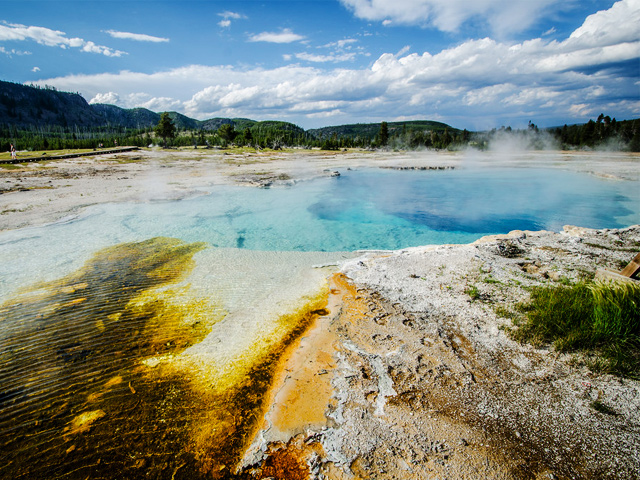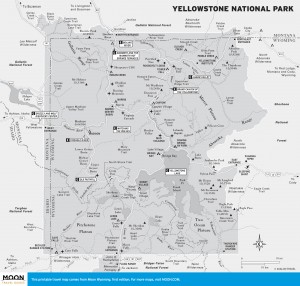
Biscuit Basin in Yellowstone National Park. Photo © m01229, licensed Creative Commons Attribution.

Yellowstone National Park
It’s always interesting to watch visitors’ expressions when you tell them that in Yellowstone National Park they are standing atop one of the world’s largest active supervolcanos . . . and that it is overdue for an apocalyptic eruption. While these facts are true, the reality is much less threatening. Indeed there have been three phenomenal eruptions over the course of the last two million years, and the patterns do indicate that the volcano is overdue to erupt. But scientists agree that the chances of a massive eruption in the next 1,000 or even 10,000 years are very slight. For the time being, anyway, the supervolcano that gives rise to Yellowstone’s extraordinary geothermal features is all bark and no bite—thankfully.The first supervolcanic eruption 2.1 million years ago was 6,000 times more powerful than the 1980 eruption of Mount St. Helens, spouting rock and ash in every direction from Texas to Canada, Missouri to California. The eruption emptied the magma chamber located just underneath the park and caused a massive sinking of the earth, known as a caldera, within the confines of what is now the park. Small lava flows filled in the perimeter of the Huckleberry Ridge Caldera over the course of hundreds of thousands of years.
The most recent massive eruption took place roughly 640,000 years ago and created the Yellowstone Caldera, which is 30 by 45 miles in size.The second major, but smaller, eruption occurred 1.3 million years ago and created the Henry’s Fork Caldera. The most recent massive eruption took place roughly 640,000 years ago and created the Yellowstone Caldera, which is 30 by 45 miles in size. The perimeter of the Yellowstone Caldera is still visible in places throughout the park. Hike up Mount Washburn on Dunraven Pass between Canyon and Tower, look south, and you will see the vast caldera formed by the most recent eruption. The caldera rim is also visible at Gibbon Falls, Lewis Falls, and Lake Butte. As you drive between Mammoth and Gardiner, look at Mount Everts to the east and you will see layers of ash from the various eruptions.But volcanic activity is not a thing of the past in Yellowstone. The magma, which some scientists think is just 5 miles beneath the surface of the park in places as opposed to the typical 40, has created two enormous bulges, known as resurgent domes, near Sour Creek and Mallard Lake. The Sour Creek Dome is growing at an impressive rate of 1.5 inches per year, causing Yellowstone Lake to tip southward, leaving docks on the north side completely out of the water and flooding the forested shore of the south side. In addition, there are roughly 2,000 earthquakes every year centered in Yellowstone, most of which cannot be felt. The earthquakes shift geothermal activity in the park and keep the natural plumbing system that feeds the geyser basins flowing. They also suggest volcanic activity. In early 2010, a series of more than 2,000 small earthquakes (the largest registered 3.8 on the Richter scale) rocked the park, with 16 quakes registering a magnitude greater than 3.0. A 1985 swarm, still the largest to date, recorded more than 3,000 earthquakes over three months, with the largest registering at 4.9 on the Richter scale.
Still, the scientists at the Yellowstone Volcano Observatory have no reason to suspect that an eruption, or even a lava flow, is imminent. For more than three decades scientists have been monitoring the region for precursors to volcanic eruptions—earthquake swarms, rapid ground deformation, gas releases, and lava flows—and although there is activity, none of it suggests anything immediately foreboding. Current real-time monitoring data, including earthquake activity and deformation, are available online. The bottom line is that the volcano is real and active, but certainly not a threat in the immediate future, and not a reason to stay away from this awe-inspiring place.
Excerpted from the Second Edition of Moon Montana & Wyoming.